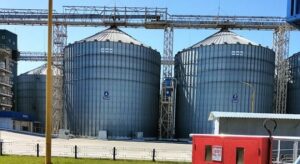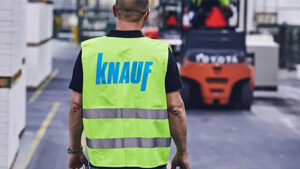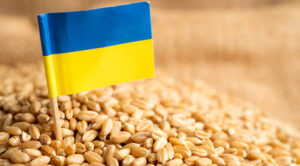
IT specialists of one of the largest grain market operators in Ukraine, JV Nibulon LLC, together with the IT-Enterprise team, have completed the restart and digitalization of the quantitative and qualitative accounting of the elevator network, the grain trader’s press service reported on its Facebook page.
According to the report, the project to optimize quantitative and qualitative accounting included improvement of business processes for grain accounting, additional processes for logistics management and costing.
“The establishment of a new efficient version of the quantitative and qualitative accounting business process made it possible to automatically track the movement of grain, its key indicators, and the funds spent on processing and transportation from the moment it arrives at the elevator to the shipment to the end consumer. This allows us to calculate the exact cost price and, accordingly, the profitability. And most importantly, we understand what impact can be made at each stage to improve financial and service performance,” said Nibulon’s IT Director Mykola Riasko.
The ultimate goal of the project is to switch to a fully digital elevator model, the principle of which is based on managing and coordinating all processes with digital systems. This concept is gradually being scaled up to all 23 Nibulon elevator complexes.
“If we describe the results of the quantitative and qualitative accounting digitalization project in three theses, firstly, it is the simplification and automation of business processes, and the acceleration of their passage. Secondly, it is the accuracy of accounting, which ensures the clarity and relevance of the company’s financial position. Thirdly, it is more customer-oriented, as the process of providing services has become better and faster,” emphasized Ryasko.
Nibulon added that the digitalization project also contributed to the unification of accounting processes at all branches of the company and improved integration with equipment and third-party systems, which ensured effective management of business processes.
JV Nibulon LLC was established in 1991. Prior to the Russian military invasion, the grain trader had 27 transshipment terminals and crop reception complexes, capacity for simultaneous storage of 2.25 million tons of agricultural products, a fleet of 83 vessels (including 23 tugs), and owned the Mykolaiv Shipyard.
“Before the war, Nibulon cultivated 82 thousand hectares of land in 12 regions of Ukraine and exported agricultural products to more than 70 countries. In 2021, the grain trader exported the highest ever volume of 5.64 million tons of agricultural products, reaching record volumes of supplies to foreign markets in August – 0.7 million tons, in the fourth quarter – 1.88 million tons, and in the second half of the year – 3.71 million tons.
Nibulon’s losses due to Russia’s full-scale military invasion in 2022 exceeded $416 million.
Currently, the grain trader is operating at 32% of capacity, has created a special unit to clear agricultural land of mines, and was forced to move its headquarters from Mykolaiv to Kyiv.

The German company Knauf will build a plant for the production of drywall and dry building mixtures in Borshchiv (Ternopil region), with investments in the project amounting to EUR 150 million, said Dmytro Kysylevskyi, deputy chairman of the parliamentary committee on economic development.
According to him, the design capacity of the new plant will be 30 million square meters of drywall and 320 thousand tons of dry mixes.
“This will be the second Knauf plant in Ukraine. The first one is located in Kyiv and is currently operating at full capacity – about 25 million square meters of drywall and 200 thousand tons of dry mixes. This is enough to meet the domestic demand of the Ukrainian market, but after the war, the demand will increase significantly. That is why the new plant in Borshchiv is an investment with faith in victory,” Kysylevsky wrote on his Facebook page.
Previously, Knauf also owned a plant in Soledar (Donetsk region), which was destroyed by the occupiers. The company took its employees out and employed them at the Kyiv plant, which employs 425 people in total, the MP said.
Kysylevsky noted that Knauf has officially announced that it has stopped investing and is leaving the Russian market. At the same time, in 2023, the National Agency for the Prevention of Corruption (NAPC) included Knauf in the now canceled list of international sponsors of war because of its continued operations in Russia.
“According to my information, they have finally left Russia. And all international companies that have not yet done so should do the same. The best way to improve your reputation after a long withdrawal from Russia is to build factories in Ukraine,” the MP emphasized.
Knauf is a leading global manufacturer of gypsum and building materials.
According to Opendatabot, by the end of 2023, Knauf’s Kyiv plant (Knauf Gypsum Kyiv LLC) increased its net revenue by 65% to UAH 3.53 billion, and its net profit by 2.6 times to UAH 1 billion.

Since the beginning of 2024-2025 marketing year and as of January 8, Ukraine exported 22.442 mln tonnes of grains and pulses, 705 thsd tonnes of which were shipped this month, the press service of the Ministry of Agrarian Policy and Food reported, citing the data of the State Customs Service of Ukraine.
According to the report, as of the same date last year, the total shipments amounted to 19.422 mln tons, including 1.03 mln tons in January.
In terms of crops, since the beginning of the current season, 9.977 million tons of wheat have been exported (209 thousand tons in January), 1.976 million tons of barley (8 thousand tons), 10.8 thousand tons of rye (0) and 10.162 million tons of corn (487 thousand tons).
The total export of Ukrainian flour since the beginning of the season as of January 8 is estimated at 38.1 thsd tonnes (0.5 thsd tonnes in January), including 35 thsd tonnes of wheat (0.5 thsd tonnes).

Prices for carrots in Ukraine have been rising for several weeks, analysts of the EastFruit project report. Experts explain the rise in prices for this product by the fact that many local producers have exhausted stocks of quality root crops, whose harvest in 2024 was significantly affected by unfavorable weather conditions.
At the moment, the price range for carrots is already voiced in the range of 25-32 UAH/kg ($0.59-0.76/kg), depending on the quality and volume of offered batches of vegetables, which is on average 10% more expensive than a week earlier.
Market participants explain another price increase in this segment by stable demand for quality carrots. At the same time, the supply of these root crops on the Ukrainian market has noticeably decreased this week. Many producers have already announced the end of the season of realization of available stocks of products. Some farms offer for sale residual lots or refrain from selling at all, hoping to realize vegetables closer to spring at higher prices.
It should be added that today the price of carrots in Ukraine is already on average 2.3 times higher than in early January 2024. Industry experts explain this price level by the reduction in the harvest of this product in the current season due to weather anomalies in the summer.
You can get more detailed information about the development of the market of carrots and other horticultural products in Ukraine by subscribing to the operative analytical weekly – EastFruit Ukraine Weekly Pro. Detailed product information is available at here.

According to the Ukrainian Center for Transplant Coordination (UCTC) on its website, 28 medical centers performed transplants. In particular, 337 patients received kidney transplants, 107 received liver transplants, and 71 received heart transplants. In addition, after a significant break, a lung transplant was performed at the Heart Institute of the Ministry of Health of Ukraine.
According to the UCTC, the largest number of organ transplants were performed by Lviv TMC (140) and the National Center of Surgery and Transplantation named after A.A. Shalimov (140). Shalimov National Center of Surgery and Transplantation (91) and the Heart Institute (52).
At the same time, according to the UCC, the fourth largest private clinic in terms of the number of transplants is Oberig (Capital LLC, Kyiv), where 44 liver and two kidney transplants were performed.
The UCTC also reports that in 2024, the number of hematopoietic stem cell transplants increased by 18%: 404 bone marrow transplants were performed in 11 medical institutions, 58 of which were for children.
The largest number of bone marrow transplants was performed at the National Children’s Specialized Hospital “Okhmatdyt” (81), Kyiv City Center for Nephrology and Dialysis (74), and Cherkasy Center for Oncology, Hematology, Transplantation and Palliative Care (72).
At the same time, five medical centers perform allogeneic transplants, including three from unrelated donors.
As of the beginning of 2025, there are 3578 patients on the national waiting list, including 2276 waiting for kidney transplants, 586 for liver transplants, and seven for split liver transplants.
There are 615 patients on the waiting list for heart transplantation, 50 patients are waiting for lung transplantation, and 26 patients are waiting for a heart-lung complex.
There are 20 patients waiting for a kidney and pancreas transplant.

In December 2024, Ukraine imported 8 tons of cattle in live weight worth $57 thousand, which is 73% less than in December 2023, the Association of Milk Producers (AMP) reported, citing preliminary data from the State Customs Service.
The industry association noted that Ukraine also reduced imports of chilled beef by 26% to 17 tons and frozen beef by 9% to 203 tons compared to November 2024. Compared to December 2023, imports of chilled beef increased by 57%, and imports of frozen red meat increased by 1%.
In general, in 2024, Ukraine reduced imports of cattle by 25% to 478 tons, increased imports of chilled beef by 13% to 154 tons and 17% of frozen beef to 2.54 thousand tons.